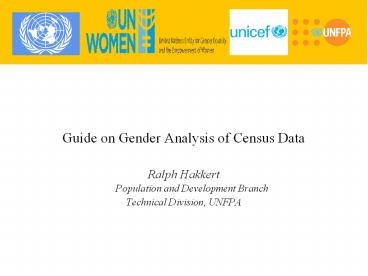Guide on Gender Analysis of Census Data - PowerPoint PPT Presentation
Title:
Guide on Gender Analysis of Census Data
Description:
Guide on Gender Analysis of Census Data Ralph Hakkert Population and Development Branch Technical Division, UNFPA Why do we hear so little about censuses in gender ... – PowerPoint PPT presentation
Number of Views:145
Avg rating:3.0/5.0
Title: Guide on Gender Analysis of Census Data
1
- Guide on Gender Analysis of Census Data
- Ralph Hakkert Population and Development Branch
- Technical Division, UNFPA
2
Why do we hear so little about censuses in gender
statistics ?
- Censuses have obvious limitations, especially
with respect to the subjects that can be
investigated - No Gender-Based Violence
- No Female Genital Mutilation
- No Male and Female Fertility Preferences
- No Distribution of Resources within the
Household - No Time Use Information, etc. etc. etc.
- However,
- A lot of census information is relevant to gender
analysis - Some censuses have special questions on gender
topics - Censuses can be disaggregated to much more
specific levels - Census data can (sometimes) be merged with
surveys on specific topics.
3
Some interesting census questions in specific
censuses
- Time spent caring for children own or of other
people (Australia) - Time spent for sick or disabled household members
(Aruba, Australia, Iran) - Unpaid domestic work carried out in the household
(Australia) - Matrix of family relationships between household
members (Ireland) - Children Ever Born, not only for women, but also
for men (Bermuda) - Income data detailed by household members or by
source (several) - Trans-gender identity (India, Thailand)
- Question about homosexual unions (Germany)
- Any kind of activity which generated income
(several) - Fertility preferences (Kazakhstan, Korea)
- Ownership of land and/or property (Nepal)
- Assistance received in the delivery (Cambodia)
(also 16 CODs) - Sex of the person sending remittances (El
Salvador) etc.
4
Some interesting census questions in specific
censuses
- 17 countries ask for the date or the age of the
woman at the time of her first marriage - 11 countries ask for the date (year) or the age
of the mother at the time of birth of the first
live-born child - 23 countries make it possible to identify
domestic servants in the household. - On the other hand, 8 countries do not
disaggregate births by sex - Viet Nam is an example of a country that did
implement this disaggregation and made good use
of it for the analysis of the sex ratio at birth
5
Contents Part One
- Introduction......................................
.............................................2 - PART ONE - Background and Conceptual
Clarifications for Gender Analysis of Census
Data......................................5 - 1. Gender in Population and Housing
Censuses............................6 - 2. Conceptual Clarifications on Gender Equality
and Gender-Responsive Data Analysis...............
........................................16 - Box 1 Multivariate Analysis to Disentangle
Intra Group Variability and Interrelationships - Box 2 Life course approach
6
Contents Part Two
- PART TWO 10 Key Gender Issues Analysed with
Census Data.......................................
..................................................
........29 - 3. Fertility......................................
..................................................
.....31 - 4. Sex Ratio at Birth and During the Life
Course....56 - 5. Marital Status...74
- 6. Household Composition...97
- 7. Poverty and Living Conditions...12
6 - 8. Education and Literacy...137
- 9. Work, Paid and Unpaid...149
- 10. Migration...160
- 11. Disability...175
- 12. Access to Social Security and Health
Insurance...188
7
Conclusion and Annexes
- Conclusions...195
- APPENDICES........................................
...................................197 - Analysis of Census Questionnaires.................
....................197 - Mapping of Resources on Gender Statistics.........
...............205 - Overview of the Evolution of Gender
Statistics..................208 - Improving the Production and Analysis of Gender
Stats....212 - How to Apply this Guide in a Country
Context..................218
8
Structure of Chapters in Part Two
- What is it ?
- Why is it important ?
- Data issues
- Tabulations
- Indicators
- Interpretation
- Multivariate and further gender analysis
- Policy and Advocacy

